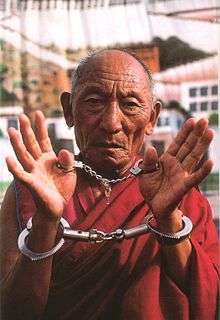Palden Gyatso

Palden Gyatso (born 1933 in Panam, Tibet) is a Tibetan Buddhist monk who was born in Tibet in 1933.[1] During the Chinese invasion of Tibet he was arrested for protesting and spent 33 years in Chinese prisons and labor camps,[1][2][3] where he was extensively tortured.[1] After his release in 1992 he fled to Dharamsala, (North India) in exile.[4] He is still a practising monk and political activist, traveling the world publicizing the cause of Tibet.[4][5] He is the subject of the 2008 film Fire Under the Snow.[6]
Life
Palden Gyatso was born in the Tibetan village of Panam in 1933. This place is located at Nyangchu river between Gyantse and Shigatse. In 1943 he entered Gadong monastery as a novice monk. During the Chinese invasion he was nominated as a fully ordained monk of the Gelug school. Later he studied in Drepung monastery which is close to Lhasa.
After the 1959 Tibetan uprising, Palden Gyatso was arrested by Chinese officials.[1] He spent the following 33 years in different Chinese prisons and labour camps.[3] He was forced to participate in barbarous reeducation classes and was brutally tortured,[3][7] leading to irreversible physical damage. During this time, he continued to abide by the Dharma (Buddha's teachings).[4]
1992 Palden Gyatso was released. He escaped to Dharamsala in India,[4] the place of the Tibetan exile government. There he wrote his autobiography Fire Under The Snow in Tibetan,[7] since translated into many other languages and the subject of a forthcoming film.[4][6]
During his following visits in America and Europe he became politically active as an opponent of the Chinese occupation in Tibet and as a witness of many years under Chinese confinement.[3] In 1995 he was heard by the United Nations Human Rights Council in Geneva.[1] In 1998, he won the John Humphrey Freedom Award from the Canadian human rights group Rights & Democracy.[8] In 2009 he spoke at the inaugural Oslo Freedom Forum.
These days Palden Gyatso is living in Dharamsala and following his Buddhist studies.[4]
See also
Literature
- Fire Under The Snow, Palden Gyatso, The Harvill Press, 1997, London (ISBN 1 86046 509 9)
References
- 1 2 3 4 5 Palden Gyatso bio
- ↑ Wartofsky, Alana; Jenkins, Mark; Freedom, Justice and a Little Rap and Reggae, Washington Post, June 15, 1998
- 1 2 3 4 Rosenthal, A. M. On My Mind; You Are Palden Gyatso, The New York Times, April 11, 1995
- 1 2 3 4 5 6 Palden Gyatso bio at Free Tibet Campaign
- ↑ 3 Tibetans Continue Hunger Strike Washington Post, February 26, 2006, Page E18
- 1 2 Fire Under the Snow
- 1 2 Moffett, Shannon Monk reflects on time in prison – Palden Gyatso, a long-time prisoner of Chinese-occupying government, speaks about the torture he endured, The Stanford Daily, May 2, 2000
- ↑ "John Humphrey Freedom Award 2009". Rights & Democracy. 2010. Retrieved 11 May 2011.
External links
- Waller, Douglas Weapons Of Torture, CNN, March 31, 1998
- Yangzom, Tsering Walk for Tibetan freedom passes through Boston area, The Boston Globe, July 31, 2005
- Palden Gyatso - 33 years in Chinese concentration camps
|